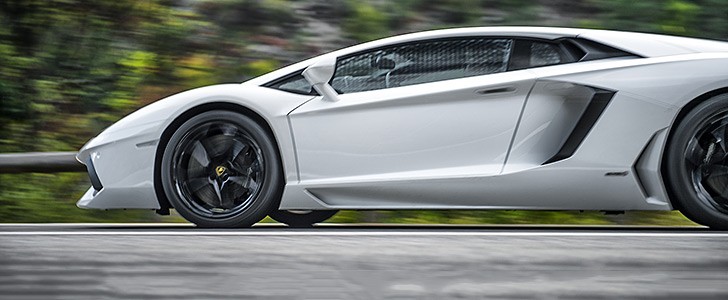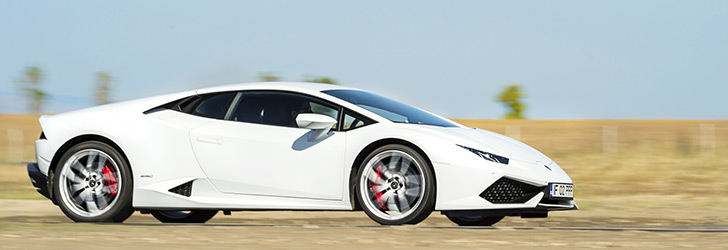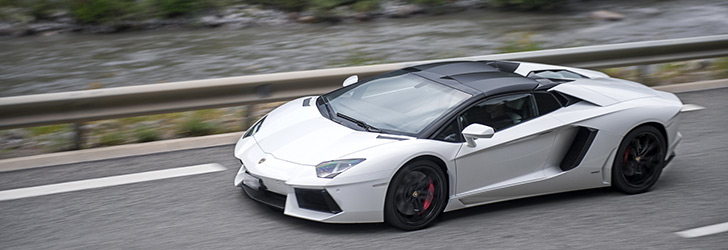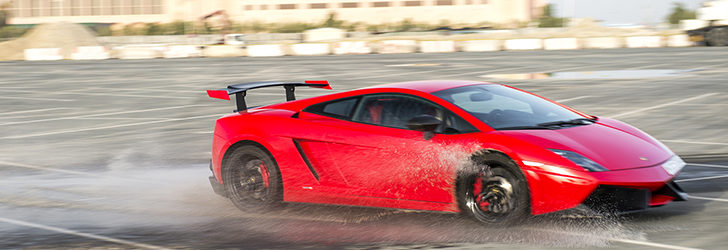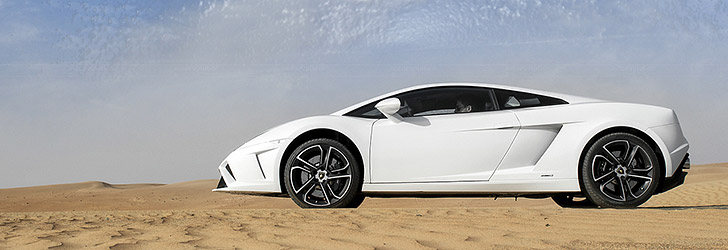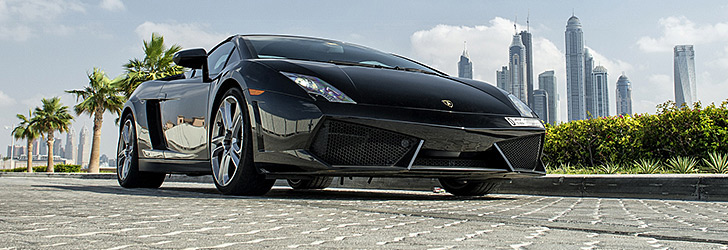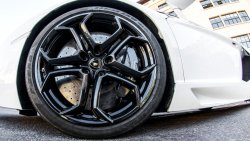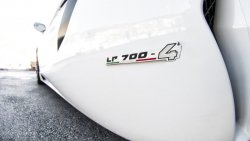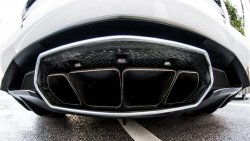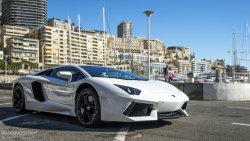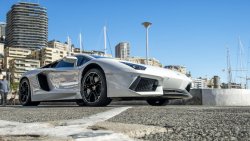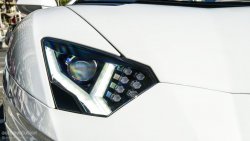LAMBORGHINI Aventador Review
OUR TEST CAR: LAMBORGHINI Aventador LP700-4 2012
Lamborghini has always packed a punch worthy of K.O. territory, so when the company prepared to introduce its new heavyweight fighter, the Aventador, it knew that this had to prove something about the entire brand.
The supercar arena is the home of spectacular fights by definition, but recent times have turned it into a full-fury battlefield. Competition has evolved to such an extent that each fresh arrival not only has to score more points than its predecessor, but it must deliver at least one characteristic blow that makes it special on the ring.
These are just two reasons for which Lamborghini didn't waste time with unimportant goals such as being the fastest or the most outrageous when training its V12 fighter for the match.
Sant'Agata Bolonese had one simple target in mind - the Aventador had to be the best. They planned to release a creation that would sit above all other mainstream supercars (read: machines that do not cross the half-a-million dollar line).
The public was expected to be hypnotized, with the coach watching this world-wide theater act from the comfort of its armchair in Ingolstadt. This is how it was planned and no expense was to great to turn the first Lambo entirely conceived under Audi ownership into a heart, and cheque winner.
It all started with a clean sheet o paper and the name of the bravest bull they could think of. Aventador may have died fighting in an arena in Zaragoza back in 1993, but the bull was such a respectable adversary that he received a trophy for its courage.
While the bovine probably didn't understand too much of the award ceremony, especially due to its post-mortem nature, the designers and engineers had to make sure that they pass its spirit on to the car.
Each and every V12 Lamborghini model released from the company's inception in 1963, including the Murcielago, uses the original V12 engine designed by Giotto Bizzarrini as a starting point, albeit with modifications ranging from major to extreme.
New makeup wasn't going to cut it for the Aventador, so an all-new heart was built for this car. And since they were there, they also threw in a new transmission.
Ferrari and almost everybody else in this league use aluminum for the body construction, so nothing less than carbon fiber could do for the mega-project. Lamborghini had been experimenting with full carbon fiber body construction ever since the Countach, but only separate body parts made it into production. This meant that the Aventador was the perfect occasion to finally make this happen.
Big Lambos of the past had the bad habit of showing you that their connection to the world of bull fighting is not just a marketing scheme, usually with painful consequences. However, the aforementioned market conditions mean that all these impressive parts of the car had to be included into a whole that would also have to be more usable.
The Aventador has landed and we can't deny the torero-scaring performance figures or the looks that turn heads with the same force the moon causes tides. Nevertheless, we recently set out to see how those numbers are translated in the real world and what the car feels like when you're not blinded by its appearance.
Like we said, the Aventador is also about the Lamborghini brand altogether. This company was born from a mix of automotive passion and ego-fueled emotions. Even its first engine, the V12 that lived on for more than half a century, came to the world in a controversial way. Ferruccio Lamborghini couldn't agree on the final details of the powerplant with Giotto Bizzarrini, the man who designed it, and wouldn't pay him for the job until he was legally forced to.
Just like a girl whose wild beauty is only matched by her caprices, Lamborghini needed someone to manhandle it and eventually help it settle down a bit, all with the aim of becoming an even better company. But the secret lies within the balance between the two sides and we are now sitting in front of it's four-wheeled incarnation.
All these thoughts rush into our minds as we step over the wide seals that scream out the car's name. The access is easier than we expected and the smell of fresh leather is telling us it's time to uncover that jet fighter engine start button and drive away.
Sometimes you simply walk by a construction site and the sheer depth of the foundation that's being put together tells you that a gargantuan architectural project is about to rise. You get the same feeling when you find out the exterior dimensions of the Aventador.
The lunacy of the 2,26 meters (88.98 in.) in width is only matched by the absurd height of 1.136 mm (44.72 in.), while the 4,78 meters (188.19 in.) in length make sure you don't mistake this creature for a junior supercar.
A carbon fiber construction was a sine qua non for Lamborghini's flagship vehicle and while this may have brought certain R&D difficulties, it's the designers of the car that felt the real pressure of the project.
The carbon fiber structures are produced in-house and so is the styling, but the designers in the Centro Stile Lamborghini had to fight for the right of penning this one.
The company threw in a blank drawing board, a pair of scissor doors, a few requirements dictated by the engineering department and concluded by saying "may the best team win!". The company's own designers competed with those from the outside for the project. The aim was to create something entirely new, but which would instantly be recognized as a Raging Bull.
The flow of ideas , with the proposals ranging from a modern interpretation of a Miura to whatever futuristic sketch one can think of and the people form Sant'Agata Bolognese won. Let's see what made their proposal the best.
The lines of a Lamborghini are one of the most important elements that sell the car. This means that the designers couldn't afford to disturb this with aerodynamic elements, preferring to integrate these into the design. In the process, they also drew inspiration from the aeronautical industry.
The Aventador starts with a remarkably low structure which clearly knows the concept of labor division. The head-turning is done by the fresh, sharp lines and once the attention is captured, there are multiple familiar elements that burn the name "Lamborghini" into your mind. The latter include the shape of the air intakes, which are accentuated by black surrounds, a common feature for all the air intakes and outlets of the car. Another characteristic visual element of the brand is the the "Y" theme used for the headlights.
The profile of the car can be defined by drawing one single line. This approach was chosen because the designers knew that fire-breathing V12 needed generous air intakes on the sides, so dividing the car into the typical three zones was not an option. The C-pillars also integrate a set of air intakes, which vary their opening according to the thermal needs of the powerplant - thank you Murcielago.
As for the roof, this mixes two elements. On one hand we have the aforementioned flowing of the form, which brings a low line, which is combined with inspiration drawn from the world of insects. The sculpture-like transparent engine cover, probably the only true compromise function has made for form in this car, follows both of these pathways.
When an Aventador performs an overtaking maneuver, you may notice three areas of the rear end, as well as a fourth hidden one. We'll start from the top down, which brings us to the rear spoiler. This normally sits hidden within the car's lines and has two other positions. An 11-degree tilt angle provides downforce when driving in the mid-range speed area, while heading towards the top of the speedometer will bring a 4-degree angle.
The taillights use the trademark "Y" theme and in between them, just under the "Lamborghini" badging, we find the rear-view camera - this position keeps it clean for longer.
The massive air vents placed at a great distance from one another help emphasize the impression of width, while the lower area is dominated by the massive diffuser. This works together with the flat underbody to keep the car on the road and integrates the exhaust. Don't be fooled by the latter's domestic character shown in the city, it adores spitting flames every once in a while.
While the exterior could only show a limited amount of aeronautical industry-inspired elements, the interior is nothing short of a jet fighter feast. The traditional scissor doors and the beefy door entry sills manage to allow a decent access and once you're inside, the dashboard and the center console immediately grab your attention.
The instrument panel relies on TFT LCD displays, but its areas are separated as if we were talking about classical instruments. A round instrument that displays revs, speed and the gearbox information sits in the center. The instrument panel is customizable and this can be seen best here, where you can place either speed or revs in the foreground and leave the other in the background.
This is flanked by smaller areas for showing engine parameters like oil pressure and temperature, as well as water temperature and fuel level. In addition to that, these also display the trip computer and various vehicle information.
This has to be one of the best examples of ergonomics in the automotive industry. That's because it's also one of the most complex and eye-catching, but works perfectly and is easy to read.
The center console arrangement of controls is just as innovative and almost as easy to use. Even the engine start button that's hidden under a cover doesn't bring functional drawbacks. Lamborghini placed some of the screws that keep the trimming in place in plain sight, in order accentuate the fighter plane theme of the cabin.
While the upper area of the interior is loaded with controls and design elements, the lower one keeps things simple. The pedals for example, can be used as a definition of minimalist design.
The seats have sculpted shapes and while they can serve you well during track use, they'll also be your friends during long trips. It won't take you long to find a suitable driving position and, once you do, all the controls, from the paddles to the button, will be within your reach. Another element that helps you concentrate on the driving is the pleasing level of front and side visibility.
It's obvious that Audi's guidance has brought the Italians translations for the words "comfort" and "ergonomics". Unfortunately, somewhere along the way the Germans and the Italians got lost in translation.
How else could you explain the fact that the navigation system on the most expensive Lamborghini in the range is shared with certain previous-generation Audi models?
While you can pretend to not notice this, it's more difficult to get over the need for more space. The cabin provides enough of it for the driver and the passenger, but it should've been larger considering the exterior dimensions. The first clue for this is the mediocre storage space. You have a tiny glovebox, a compartment between the seats and some space behind them, but, again, you are left wanting more.
Opening the luggage compartment certainly won't make things better, as you'll only find 110.5 liters (3.9 cu. ft.) of space. This can be extended to 150 liters (5.3 cu. ft.) if you also use the space behind the seats.
Modern supercars have reached a point where a drive through a crowded city isn't the equivalent of a suicide anymore, but the Aventador isn't very good at this game. There's only so much engineering and technology can do to help a supercar around town when the principles it was built on defy this kind of transportation.
For example, the 226 centimeters (88.98 in.) of width are part of the Aventador's breathtaking visual aura, but you'll feel discomfort from every one of them when you're navigating though the urban mayhem.
The Integrated Shifting Rods automated manual transmission is an even bigger problem. Just like the engine, this is packed with technology, but unlike the powerplant, which has no problem dealing with the stress of urban driving, the transmission can't fully face the challenge.
It was built to deliver neck-snapping shifts, as well as generate emotions even during slower ones and it does. However, it doesn't have the smoothness required by stop & go traffic and its light acceleration shift delay becomes quickly bothering on many occasions. What's more, you can feel the clutch is being punished each time you have to perform a set of maneuvers in a tight space.
The Aventador does has some redeeming features though. It all starts with the well-implemented nose lift system, which brings an extra 40 mm (1.57 inches) of ground clearance. At usual city speeds, the system stays on, so you don't have to press its button each time you need it.
In addition to that, the front and side visibility is surprisingly good. Just like in the case of the dashboard, this is an example which proves that a flamboyant design doesn't have to be a headache in the real world.
As for the rear visibility, this is poor, but the supercar can be ordered with front and rear parking sensors, as well as with a rear-view camera.
The Aventador's 444 hp/tonne power-to-weight ratio is enough to convince anybody that this car delivers stratospheric performance. However, the big bull knows how to do so much more than chase the red cape.
Imagine the feeling you get when you drive a six-cylinder sports car hard - let's say at eight tenths - the Aventador manages to offer you about the same feeling during normal driving. All the elements, especially the steering and the suspension, mix and allow this car to be incredibly fun to drive even during a moderate speed urban drive.
It's the same story with the exhaust. The sound produced by the Aventador led us to believe that it doesn't come from a voice, but rather from a choir comprised of at least twelve of them. At full throttle, this can literally be perceived as a threat by people from outside the car. But the really interesting fact is that its complexity allows it to please your ears regardless of the speed, so you can enjoy it during normal driving too.
You really don't need to push the Aventador too hard in order to feel alive behind the wheel. Another argument in favor of this is the fact that you can find tons of low-end grunt and linear power delivery hidden inside the twelve cylinders of the engine.
If you're really sure you want to unleash the Aventador, you'd better be prepared to endure some pain. Literally. When you exploit the full potential of the Independent Shifting Rods automated manual box, the 40 ms shifts hurt, even though as a driver and you've tensed your muscles in preparation for the process.
Introduce the brake pedal to the floor mat underneath for long enough and your face will also hurt. The Aventador, in all its size, needs just 32 meters (106 ft.) to go from 100 km/h (62 mph) to a complete stop.
Once you use the Aventador's full deceleration power, you'll definitely store the experience in your memory. The stopping power is overwhelming, it has to be - up front, we have 400 mm rotors with six-cylinder grabbers, while the rear axle makes use of 380 mm discs with four-cylinder calipers. At the back, we also have a pair of single-piston calipers that serve the electric parking brake.
Seen from the outside, a high-speed braking maneuver an even more memorable experience. That's because, thanks to the carbon fiber construction, the car is considerably lighter that you'd think judging by its appearance. Seeing this massive bull kill speed with such thirst makes the word "impressive" seem like an understatement.
Abuse the Aventador and it will all feel like you're in an extreme amusement park. Let's take the launch control, for example. Technically speaking, this is a no-ESP process that uses a 4,200 rpm take-off to take you past the 62 mph in 2.9 seconds and onto a quarter mile time of 10.9 seconds at 133 mph (214 km/h). What actually happens during the first meters of such a run is overwhelming.
The Aventador gets off the line so quickly that your brain doesn't have the time to fully assess the situation. As the four tires spin a bit in search for traction, you enter that state of 3rd person view slow-motion reportedly felt by some drivers in the moments that precede an accident. By the time you're fully aware of what's going on the shift from first to second arrives and you're left dizzy once again.
Just like in a virtual mountain rousse ride, you can select the level of difficulty. There are three buttons on the dashboard that control the car's driving modes: Strada (road), Sport and Corsa (track).These influence the behavior of the engine, gearbox, differential, steering and ESP.
The Corsa setting only offers a manual mode for the gearbox, while also allowing hefty slip angles before asking the ESP to bring things back on track. This mode also increased the violence level of the gear changes.
The other two driving modes are more civilized, but you'll need a bit of time to get used to the ISR automated manual. Lamborghini went down this pathway in search for emotional gearshifts and this is precisely what you get. While a double-clutch transmission gear change is efficient but has no feel, here you have a sense of occasion each time the gearbox does its job.
Like we said, you'll need some time to become accustomed with the automated manual. That's because in the Strada and Sport modes, while under automatic operation, the shifts can be a bit awkward due to a certain delay that sometimes accompanies them. We most often found ourselves in the Sport Manual setup, where, if you ease off the throttle a bit during the shift, the process is instantaneous and jolt-free.
Lamborghini tells us that the Aventador delivers a 20 percent efficiency boost compared to the Murcielago. To be more precise, there's a 17.2 l/100 km rating for the European combined cycle. As for the Aventador's EPA ratings, this sit at 11 mpg for the city, 17 mpg for the highway and 13 mpg for the combined cycle. During our test drive, the Aventador returned an efficiency of 24 l/100 km (9.8 mpg).
When you're done thinking about the green side of a supercar, you can indulge yourself in some throttle pedal pleasures. Do this in an Aventador and you'll be in for the aforementioned roller coaster ride. You know that you're going to enjoy the experience even before it starts, mainly thanks to the out-of-this-world steering. This offers perfect feedback and weight, just like the steering wheel comes with a perfect grip. We have to mention that we're dealing with a hydraulic mechanism that comes with 3 servotronic setups handled by the aforementioned driving modes.
Accuracy. This is the word that perfectly describes the Aventador's handling. The hydraulic steering and the AWD work together with the pushrod suspension and the massive tires to offer an unforgettable driving experience. The level of grip is phenomenal and you really need a "closed course" to reach this car's handling limits.
Understeer is present in tight corners, where a different setup could've improved the handling. Apart from that, when you drive within the vast limits of the grip, you can play with this machine as if it was your own body, or rather a version of it that goes round corners faster than you dare push it.
The chassis is extremely well balanced and it's easy to correct slight trajectory deviations with a small lift. In the Corsa mode, or when you've turned off the ESP completely, a generous throttle application is enough to get the back out. The sticky tires make the maneuvers rather violent, but the car is not difficult to control after it has lost traction.
The supercar arena is the home of spectacular fights by definition, but recent times have turned it into a full-fury battlefield. Competition has evolved to such an extent that each fresh arrival not only has to score more points than its predecessor, but it must deliver at least one characteristic blow that makes it special on the ring.
These are just two reasons for which Lamborghini didn't waste time with unimportant goals such as being the fastest or the most outrageous when training its V12 fighter for the match.
Sant'Agata Bolonese had one simple target in mind - the Aventador had to be the best. They planned to release a creation that would sit above all other mainstream supercars (read: machines that do not cross the half-a-million dollar line).
The public was expected to be hypnotized, with the coach watching this world-wide theater act from the comfort of its armchair in Ingolstadt. This is how it was planned and no expense was to great to turn the first Lambo entirely conceived under Audi ownership into a heart, and cheque winner.
It all started with a clean sheet o paper and the name of the bravest bull they could think of. Aventador may have died fighting in an arena in Zaragoza back in 1993, but the bull was such a respectable adversary that he received a trophy for its courage.
While the bovine probably didn't understand too much of the award ceremony, especially due to its post-mortem nature, the designers and engineers had to make sure that they pass its spirit on to the car.
Each and every V12 Lamborghini model released from the company's inception in 1963, including the Murcielago, uses the original V12 engine designed by Giotto Bizzarrini as a starting point, albeit with modifications ranging from major to extreme.
New makeup wasn't going to cut it for the Aventador, so an all-new heart was built for this car. And since they were there, they also threw in a new transmission.
Ferrari and almost everybody else in this league use aluminum for the body construction, so nothing less than carbon fiber could do for the mega-project. Lamborghini had been experimenting with full carbon fiber body construction ever since the Countach, but only separate body parts made it into production. This meant that the Aventador was the perfect occasion to finally make this happen.
Big Lambos of the past had the bad habit of showing you that their connection to the world of bull fighting is not just a marketing scheme, usually with painful consequences. However, the aforementioned market conditions mean that all these impressive parts of the car had to be included into a whole that would also have to be more usable.
The Aventador has landed and we can't deny the torero-scaring performance figures or the looks that turn heads with the same force the moon causes tides. Nevertheless, we recently set out to see how those numbers are translated in the real world and what the car feels like when you're not blinded by its appearance.
Like we said, the Aventador is also about the Lamborghini brand altogether. This company was born from a mix of automotive passion and ego-fueled emotions. Even its first engine, the V12 that lived on for more than half a century, came to the world in a controversial way. Ferruccio Lamborghini couldn't agree on the final details of the powerplant with Giotto Bizzarrini, the man who designed it, and wouldn't pay him for the job until he was legally forced to.
Just like a girl whose wild beauty is only matched by her caprices, Lamborghini needed someone to manhandle it and eventually help it settle down a bit, all with the aim of becoming an even better company. But the secret lies within the balance between the two sides and we are now sitting in front of it's four-wheeled incarnation.
All these thoughts rush into our minds as we step over the wide seals that scream out the car's name. The access is easier than we expected and the smell of fresh leather is telling us it's time to uncover that jet fighter engine start button and drive away.
Sometimes you simply walk by a construction site and the sheer depth of the foundation that's being put together tells you that a gargantuan architectural project is about to rise. You get the same feeling when you find out the exterior dimensions of the Aventador.
The lunacy of the 2,26 meters (88.98 in.) in width is only matched by the absurd height of 1.136 mm (44.72 in.), while the 4,78 meters (188.19 in.) in length make sure you don't mistake this creature for a junior supercar.
A carbon fiber construction was a sine qua non for Lamborghini's flagship vehicle and while this may have brought certain R&D difficulties, it's the designers of the car that felt the real pressure of the project.
The carbon fiber structures are produced in-house and so is the styling, but the designers in the Centro Stile Lamborghini had to fight for the right of penning this one.
The company threw in a blank drawing board, a pair of scissor doors, a few requirements dictated by the engineering department and concluded by saying "may the best team win!". The company's own designers competed with those from the outside for the project. The aim was to create something entirely new, but which would instantly be recognized as a Raging Bull.
The flow of ideas , with the proposals ranging from a modern interpretation of a Miura to whatever futuristic sketch one can think of and the people form Sant'Agata Bolognese won. Let's see what made their proposal the best.
The lines of a Lamborghini are one of the most important elements that sell the car. This means that the designers couldn't afford to disturb this with aerodynamic elements, preferring to integrate these into the design. In the process, they also drew inspiration from the aeronautical industry.
The Aventador starts with a remarkably low structure which clearly knows the concept of labor division. The head-turning is done by the fresh, sharp lines and once the attention is captured, there are multiple familiar elements that burn the name "Lamborghini" into your mind. The latter include the shape of the air intakes, which are accentuated by black surrounds, a common feature for all the air intakes and outlets of the car. Another characteristic visual element of the brand is the the "Y" theme used for the headlights.
The profile of the car can be defined by drawing one single line. This approach was chosen because the designers knew that fire-breathing V12 needed generous air intakes on the sides, so dividing the car into the typical three zones was not an option. The C-pillars also integrate a set of air intakes, which vary their opening according to the thermal needs of the powerplant - thank you Murcielago.
As for the roof, this mixes two elements. On one hand we have the aforementioned flowing of the form, which brings a low line, which is combined with inspiration drawn from the world of insects. The sculpture-like transparent engine cover, probably the only true compromise function has made for form in this car, follows both of these pathways.
When an Aventador performs an overtaking maneuver, you may notice three areas of the rear end, as well as a fourth hidden one. We'll start from the top down, which brings us to the rear spoiler. This normally sits hidden within the car's lines and has two other positions. An 11-degree tilt angle provides downforce when driving in the mid-range speed area, while heading towards the top of the speedometer will bring a 4-degree angle.
The taillights use the trademark "Y" theme and in between them, just under the "Lamborghini" badging, we find the rear-view camera - this position keeps it clean for longer.
The massive air vents placed at a great distance from one another help emphasize the impression of width, while the lower area is dominated by the massive diffuser. This works together with the flat underbody to keep the car on the road and integrates the exhaust. Don't be fooled by the latter's domestic character shown in the city, it adores spitting flames every once in a while.
While the exterior could only show a limited amount of aeronautical industry-inspired elements, the interior is nothing short of a jet fighter feast. The traditional scissor doors and the beefy door entry sills manage to allow a decent access and once you're inside, the dashboard and the center console immediately grab your attention.
The instrument panel relies on TFT LCD displays, but its areas are separated as if we were talking about classical instruments. A round instrument that displays revs, speed and the gearbox information sits in the center. The instrument panel is customizable and this can be seen best here, where you can place either speed or revs in the foreground and leave the other in the background.
This is flanked by smaller areas for showing engine parameters like oil pressure and temperature, as well as water temperature and fuel level. In addition to that, these also display the trip computer and various vehicle information.
This has to be one of the best examples of ergonomics in the automotive industry. That's because it's also one of the most complex and eye-catching, but works perfectly and is easy to read.
The center console arrangement of controls is just as innovative and almost as easy to use. Even the engine start button that's hidden under a cover doesn't bring functional drawbacks. Lamborghini placed some of the screws that keep the trimming in place in plain sight, in order accentuate the fighter plane theme of the cabin.
While the upper area of the interior is loaded with controls and design elements, the lower one keeps things simple. The pedals for example, can be used as a definition of minimalist design.
The seats have sculpted shapes and while they can serve you well during track use, they'll also be your friends during long trips. It won't take you long to find a suitable driving position and, once you do, all the controls, from the paddles to the button, will be within your reach. Another element that helps you concentrate on the driving is the pleasing level of front and side visibility.
It's obvious that Audi's guidance has brought the Italians translations for the words "comfort" and "ergonomics". Unfortunately, somewhere along the way the Germans and the Italians got lost in translation.
How else could you explain the fact that the navigation system on the most expensive Lamborghini in the range is shared with certain previous-generation Audi models?
While you can pretend to not notice this, it's more difficult to get over the need for more space. The cabin provides enough of it for the driver and the passenger, but it should've been larger considering the exterior dimensions. The first clue for this is the mediocre storage space. You have a tiny glovebox, a compartment between the seats and some space behind them, but, again, you are left wanting more.
Opening the luggage compartment certainly won't make things better, as you'll only find 110.5 liters (3.9 cu. ft.) of space. This can be extended to 150 liters (5.3 cu. ft.) if you also use the space behind the seats.
Modern supercars have reached a point where a drive through a crowded city isn't the equivalent of a suicide anymore, but the Aventador isn't very good at this game. There's only so much engineering and technology can do to help a supercar around town when the principles it was built on defy this kind of transportation.
For example, the 226 centimeters (88.98 in.) of width are part of the Aventador's breathtaking visual aura, but you'll feel discomfort from every one of them when you're navigating though the urban mayhem.
The Integrated Shifting Rods automated manual transmission is an even bigger problem. Just like the engine, this is packed with technology, but unlike the powerplant, which has no problem dealing with the stress of urban driving, the transmission can't fully face the challenge.
It was built to deliver neck-snapping shifts, as well as generate emotions even during slower ones and it does. However, it doesn't have the smoothness required by stop & go traffic and its light acceleration shift delay becomes quickly bothering on many occasions. What's more, you can feel the clutch is being punished each time you have to perform a set of maneuvers in a tight space.
The Aventador does has some redeeming features though. It all starts with the well-implemented nose lift system, which brings an extra 40 mm (1.57 inches) of ground clearance. At usual city speeds, the system stays on, so you don't have to press its button each time you need it.
In addition to that, the front and side visibility is surprisingly good. Just like in the case of the dashboard, this is an example which proves that a flamboyant design doesn't have to be a headache in the real world.
As for the rear visibility, this is poor, but the supercar can be ordered with front and rear parking sensors, as well as with a rear-view camera.
The Aventador's 444 hp/tonne power-to-weight ratio is enough to convince anybody that this car delivers stratospheric performance. However, the big bull knows how to do so much more than chase the red cape.
Imagine the feeling you get when you drive a six-cylinder sports car hard - let's say at eight tenths - the Aventador manages to offer you about the same feeling during normal driving. All the elements, especially the steering and the suspension, mix and allow this car to be incredibly fun to drive even during a moderate speed urban drive.
It's the same story with the exhaust. The sound produced by the Aventador led us to believe that it doesn't come from a voice, but rather from a choir comprised of at least twelve of them. At full throttle, this can literally be perceived as a threat by people from outside the car. But the really interesting fact is that its complexity allows it to please your ears regardless of the speed, so you can enjoy it during normal driving too.
You really don't need to push the Aventador too hard in order to feel alive behind the wheel. Another argument in favor of this is the fact that you can find tons of low-end grunt and linear power delivery hidden inside the twelve cylinders of the engine.
If you're really sure you want to unleash the Aventador, you'd better be prepared to endure some pain. Literally. When you exploit the full potential of the Independent Shifting Rods automated manual box, the 40 ms shifts hurt, even though as a driver and you've tensed your muscles in preparation for the process.
Introduce the brake pedal to the floor mat underneath for long enough and your face will also hurt. The Aventador, in all its size, needs just 32 meters (106 ft.) to go from 100 km/h (62 mph) to a complete stop.
Once you use the Aventador's full deceleration power, you'll definitely store the experience in your memory. The stopping power is overwhelming, it has to be - up front, we have 400 mm rotors with six-cylinder grabbers, while the rear axle makes use of 380 mm discs with four-cylinder calipers. At the back, we also have a pair of single-piston calipers that serve the electric parking brake.
Seen from the outside, a high-speed braking maneuver an even more memorable experience. That's because, thanks to the carbon fiber construction, the car is considerably lighter that you'd think judging by its appearance. Seeing this massive bull kill speed with such thirst makes the word "impressive" seem like an understatement.
Abuse the Aventador and it will all feel like you're in an extreme amusement park. Let's take the launch control, for example. Technically speaking, this is a no-ESP process that uses a 4,200 rpm take-off to take you past the 62 mph in 2.9 seconds and onto a quarter mile time of 10.9 seconds at 133 mph (214 km/h). What actually happens during the first meters of such a run is overwhelming.
The Aventador gets off the line so quickly that your brain doesn't have the time to fully assess the situation. As the four tires spin a bit in search for traction, you enter that state of 3rd person view slow-motion reportedly felt by some drivers in the moments that precede an accident. By the time you're fully aware of what's going on the shift from first to second arrives and you're left dizzy once again.
Just like in a virtual mountain rousse ride, you can select the level of difficulty. There are three buttons on the dashboard that control the car's driving modes: Strada (road), Sport and Corsa (track).These influence the behavior of the engine, gearbox, differential, steering and ESP.
The Corsa setting only offers a manual mode for the gearbox, while also allowing hefty slip angles before asking the ESP to bring things back on track. This mode also increased the violence level of the gear changes.
The other two driving modes are more civilized, but you'll need a bit of time to get used to the ISR automated manual. Lamborghini went down this pathway in search for emotional gearshifts and this is precisely what you get. While a double-clutch transmission gear change is efficient but has no feel, here you have a sense of occasion each time the gearbox does its job.
Like we said, you'll need some time to become accustomed with the automated manual. That's because in the Strada and Sport modes, while under automatic operation, the shifts can be a bit awkward due to a certain delay that sometimes accompanies them. We most often found ourselves in the Sport Manual setup, where, if you ease off the throttle a bit during the shift, the process is instantaneous and jolt-free.
Lamborghini tells us that the Aventador delivers a 20 percent efficiency boost compared to the Murcielago. To be more precise, there's a 17.2 l/100 km rating for the European combined cycle. As for the Aventador's EPA ratings, this sit at 11 mpg for the city, 17 mpg for the highway and 13 mpg for the combined cycle. During our test drive, the Aventador returned an efficiency of 24 l/100 km (9.8 mpg).
When you're done thinking about the green side of a supercar, you can indulge yourself in some throttle pedal pleasures. Do this in an Aventador and you'll be in for the aforementioned roller coaster ride. You know that you're going to enjoy the experience even before it starts, mainly thanks to the out-of-this-world steering. This offers perfect feedback and weight, just like the steering wheel comes with a perfect grip. We have to mention that we're dealing with a hydraulic mechanism that comes with 3 servotronic setups handled by the aforementioned driving modes.
Accuracy. This is the word that perfectly describes the Aventador's handling. The hydraulic steering and the AWD work together with the pushrod suspension and the massive tires to offer an unforgettable driving experience. The level of grip is phenomenal and you really need a "closed course" to reach this car's handling limits.
Understeer is present in tight corners, where a different setup could've improved the handling. Apart from that, when you drive within the vast limits of the grip, you can play with this machine as if it was your own body, or rather a version of it that goes round corners faster than you dare push it.
The chassis is extremely well balanced and it's easy to correct slight trajectory deviations with a small lift. In the Corsa mode, or when you've turned off the ESP completely, a generous throttle application is enough to get the back out. The sticky tires make the maneuvers rather violent, but the car is not difficult to control after it has lost traction.
12
Our LAMBORGHINI Testdrives:
Photo gallery (112)
